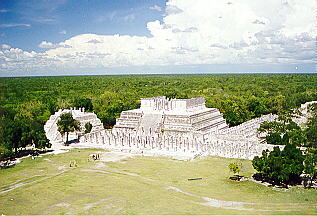| Main |
| Earthquakes |
| Climatic Changes |
| Epidemics |
| Foreign Conquest |
| Civil War |
| Social Decay |
| Governmental Disorganization |
| Economic Collapse |
| Sources |
Throughout history, theorists have often labeled changes in the climate of a particular area or region as the cause of a civilizations collapse. For example, in 2200 B.C, a dry spell in the northern area of the Mesopotamian Valley wiped out the Akkadian Empire, which stretched for almost 800 miles into the Persian Gulf. This knowledge stems from research that found a decline in the number of earthworm holes and an abundance of wind-blown pellets, this indicates an arid region with the habitants in great need of rainfall at all times.
Between 800 A.D. and 900 A.D., when the Maya Indians were reaching their
height in the classic period, they seemed to suddenly collapse. The
theories for this collapse are many as is shown in this page, but similar
to the previous example, one theory that always is looked at is that the
climate suddenly changed.

Although there isnít widespread evidence of the sudden climatic change, a study of the Yucatan shows why historians have always considered this hypothesis. Around the year 800, the Yucatan suffered a 200-year drought and it left the region drier than it had ever been. Evidence taken from lakes in the Yucatan show that the sediments were especially rich in gypsum. This mineral is present in many places and it dissolves in water, therefore researchers gather that there must have been no water in the lakes to dissolve the sediments. The notion of a lake going completely dry is hard to imagine so there must have been an incredible drought as historians predicted. One more piece of evidence taken from these lakes in the Yucatan show that there is a higher ratio of Oxygen-18 to Oxygen-16 and this clearly reveals a dry climate.
In a region where the habitants are not extremely dependent on the supply of water, a change in the climate like this one may not have as big as an effect. But, the Mayaís survival relied on the cultivation of their crops, such as Maize, which requires rainfall. With this 200-year long drought, the soil would have gone almost completely dry and there would be crop failure resulting in widespread famine and probably susceptibility to disease as well.
Although this theory does provide some substantive evidence for climatic changes being a major factor in the collapse of the Classic Maya civilization, the evidence is not widespread enough to grant it as being the one factor that caused the demise of the Mayas. This does not mean that it didnít contribute though, for any society that encounters the hardships of a long drought is not going to be as strong as they were before the drought occurred. Arguments against this theory may state that the drought did not occur everywhere so it cannot have caused the collapse of the entire civilization. This may be true, but the fact is that all the Maya tribes affected each other through their trade and in many other ways as well, and a collapse of any of these tribes would have had an effect on the Mayas as a whole.
As one can see, this theory of dramatic changes in the climate has both
pros and cons, but overall the evidence suggests that there indeed was
a change in the climate, at least in some of the regions, and because of
this the theory should be considered valid.